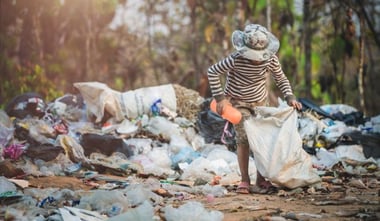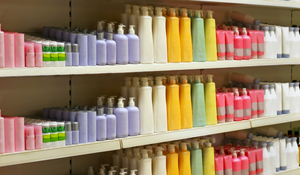
Beth Howell
Beth has been writing about the environment and climate change for over four years now – with her work being featured in publications such as The BBC, Forbes, The Express, Greenpeace, and in multiple academic journals.
When it comes to plastic credits, transparency is key. It's important for everyone involved — the collection hubs, the brands that fund projects, us, and everyone in between — to have a clear understanding of what happens to the plastic collected, and where it goes once it's been recovered.
That's why we developed our track-and-trace software. This platform was developed by our in-house team, and tracks the waste from collection to final recovery.
Something we're particularly excited about is how we've integrated AI into our software, making the process much easier and faster for the waste collectors we work with.
Want to learn more about how AI helps us keep track of the plastic we collect? Scroll down to find out everything you need to know.
And if you want to get involved in our plastic collection efforts, get in touch with our in-house team to find out more information. Once we’ve received your details, we can arrange a call to discuss which plastic recovery plan will best suit your business needs.
What's on this page?
01 | Our track-and-trace software explained02 | How we use AI in our software
03 | How auto flagging works
04 | Why is this important?
05 | Our impact
06 | FAQs
Our track-and-trace software explained
To be effective in what we do from the get go, it was important for us to create a thorough, efficient, and practical software system that brings more transparency to our operations.
So, after countless hours of work, our in-house team created our track-and-trace software. We also developed an app that makes the data-logging process more seamless for our collection teams on the ground.
The platform tracks plastic waste at each stage of recovery, including collecting the waste, sorting it, and sending it to a facility and lab for testing.
If you want to learn more about this process, check out the complete guide to our track-and-trace software.
How we use AI in our software
Whether you love or hate the concept of AI, there's no denying that it can simplify processes — and that's exactly why we decided to utilize this tech.
To outline why this is so important, let's rewind to the early days of CleanHub.
At each step of the plastic recovery journey, the app that we developed produces 'events' (another word for 'reports').
When we first started out, we would manually review every event as it came in, and publish it as fast as possible — but we’re rapidly scaling up the number of coastal communities we connect to waste management. This means we needed to find a more efficient way of recording the data.
As a solution, we integrated AI into our software to automatically review the quality of events. These events are still manually reviewed as well (for now), but we are confident enough in the quality of our automated checks, meaning we can publish the data once it's passed.
We call this technology 'auto flagging' — and we think it’s pretty cool.
.png?width=678&height=906&name=Untitled%20(1).png)
How auto flagging works
When waste collectors take photos to track the waste collected, and log them onto our app, our AI auto-flagging feature really comes into play.
We run six automated flagging rules on every event captured on our track and trace app.
Some of these are statistical rules, which essentially compare data points to an expected range. The smarter rules use machine-learning object detection models to extract information from our track-and-trace images, and then compare this to what we would expect to see.
Here are the six auto-flagging rules we use in our AI tech to bring more transparency to our operations:
- Image compliance — This identifies any bare hands and feet in our images. This might seem random, but it's to ensure that the waste collection team meets our agreed compliance standards by wearing the shoes and gloves we provide them so they can go about their work safely. Since introducing this feature, the number of workers wearing shoes not sandals increased pretty quickly
- Image weight mismatch — This flags whether the weight shown on the scale and the weight entered manually don't match up, which is key in making sure our collection data accurate
- Data weight outlier — This flags all weights that are outside the expected range for the hub. Again, flagging this issue is extremely important for transparency's sake, and making sure our collection data is accurate
- Data moisture percentage outlier — This flags moisture content that is outside of the expected range. The reason behind this is that co-processors can’t feed material to the kiln that is too wet, as it prevents them from reaching the necessary temperatures during incineration. It's also important for us. After all, we want to issue plastic credits, not water credits.
- Scale visibility — This flags whether we can see the scale in the image, which is another metric to help us ensure our data is accurate
- Material visibility — This flags whether we can identify a waste bag in the image, which is another metric to help us ensure our data is accurate
We continuously review the performance of each of these auto-flag rules to spot opportunities for improvement. Our AI models are re-trained and improved, based on the manual quality reviews done by our Operations team.
We monitor the manual flagging activity to identify frequently used manual flags that could have instead been spotted by an auto flag.
Why is this important?
At CleanHub, we know how important it is to be transparent with our operations. By using AI in our software, we can ensure that our data is accurate, and is made available to the public much faster. We believe this is the most comprehensive and inclusive approach to plastic recovery, from a monitoring and scalability point of view.
This approach is also something we think sets us above other plastic credit suppliers. By providing this level of detail and adding another level of checks, brands that partner with us can see exactly how much plastic is being collected, where from, and what happens to it once it's processed. And with greenwashing on the rise, this level of transparency is vital.
Brands need to know that the plastic we collect isn't simply going to landfills to generate more emissions and pollute the environment — it's being fed back into the economy.
Our impact
At CleanHub, we want a world free of plastic pollution — and we’re making this happen by collecting all kinds of waste from coastal communities, preventing it from being openly burnt, dumped, and reaching waterways.
So, how much waste have we collected so far? Let’s break it down.
As of May 2024, we’ve collected 9,529,203 kilograms (kg) of waste — all financed by our amazing brand partners. That’s the same weight as 317 humpback whales!
This is mainly made up of plastics but also contains paper, cardboard, and wet waste. Our collection hubs estimate that roughly 30% of the waste we collect and sort is recyclable plastic, which is then sold into the recycling process.
To make sure our projects have additionality — meaning they wouldn’t have happened without our financial support — we only incentivize and pay for non-recyclable waste. So far, we’ve collected 5,077,792 kg of non-recyclable certified waste, measured as ‘net-dry’ plastic waste where the moisture contents are deducted from the final weight.
On top of this, one of our key goals is to bring more transparency to the waste industry, which is why we also partner with waste managers beyond plastic credits, inviting them to use our technology to track collections and manage their operations.
Through this partnership, an additional 343,875 kg of waste has been tracked using CleanHub’s technology, including mixed municipal solid waste or pre-sorted waste.
Find out what else we have to offer brands on our page The Benefits of Partnering with CleanHub.
Summary
Plastic pollution is one of the biggest environmental threats facing our planet today. We're thankful that this level of tech can support us in our mission to make ocean-bound plastic a thing of the past.
We're also now publishing our data in real-time as soon as it has passed our auto-flag checks — all you have to do is visit our Live Dashboard.
Want to get involved in our plastic collection efforts? Get in touch with our in-house team to find out more information. Once we’ve received your details, we can arrange a call to discuss which plastic recovery plan will best suit your business needs.
FAQs
Where can I see CleanHub's tracking data?
You can find a real-time feed of the data coming into our system from all collection hubs on our technology page. Each event on the feed represents collected plastic being registered, sorted, and responsibly disposed of.
How does Cleanhub work?
CleanHub works with brands to fund plastic recovery in areas around the world that don't currently have an effective waste management system in place. Once a company gets in touch with CleanHub, they can choose from a variety of plans, and can even select which plastic recovery project they'd like to fund.
What verifications does CleanHub have?
CleanHub was the first plastic credit system to be verified by industry leaders in auditing environmental impact TÜV SÜD. With this certification in place, users can be assured that we are authentic, transparent, and trustworthy with our plastic recovery efforts.
Find out more about this by visitng our page on the TÜV SÜD verfication.


.webp?width=380&name=Collecting-plastic-waste%20(1).webp)
.webp?width=380&name=CEOfounders%20(1).webp)

.jpg?width=380&name=_DSC7838%20(1).jpg)
-1.jpeg?width=380&name=8a81c9a8-61ad-450f-a366-9c4b7a70237c_8G3bu04g%20(1)-1.jpeg)



%20(1).jpg?width=380&name=MRF%20opening%20photo%203%20(1)%20(1).jpg)

